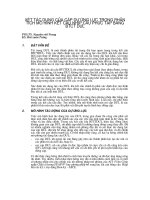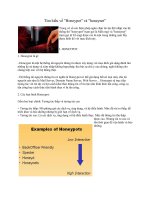Slide Tiếng Anh Tìm hiểu về XML và XSLT (Có file bài tập và bài tập mẫu đính kèm)
Bạn đang xem bản rút gọn của tài liệu. Xem và tải ngay bản đầy đủ của tài liệu tại đây (516.65 KB, 29 trang )
XSL and XSLT
defining XML document transformation and
presentation
Module Introduction
Welcome to the module, XSL and XSLT.
This module deals with the techniques of
transforming XML documents into XML,
HTML and TEXT documents using XSL
stylesheets.
This module also aims at providing a clear
understanding of creating an XSL stylesheet
using the various XSL elements.
In this module, you will learn about:
Introduction to XSL
Working with XSL
Stylesheets
A collection of commands that tells a processor how to render the visual
appearance of content in a web page.
1.
Cascading Style Sheet (CSS) is used for mechanism for adding style (e.g.
fonts, colors, spacing) to Web documents.
2.
Extensible Stylesheet Language (XSL) is used for defining XML document
transformation and presentation
Extensible Stylesheet Language (XSL)
Design to:
1.
2.
Format XML content for display purposes
Transform XML documents.
XSL consists of three languages:
1.
XSL Transformations (XSLT)
language for transforming XML documents.
1.
XML Path Language (XPath)
language for navigating the XML document.
1.
XSL Formatting Objects (XSL-FO)
language for formatting XML documents.
XSL Transformations (XSLT)
To transform XML documents into any text-based format,
including HTML, plain text, or another schema of XML
Also describes the process of transforming an XML document,
using a transformation engine and XSL (XSLT processor)
Example if transform XML into HTML
XSLT Structure and Syntax
XSLT follows normal rules of XML syntax.
In XSL, the style rules are written in a file with the extension .xsl
To associate file .xsl with an XML document using
<?xml-stylesheet href="xsl file" type="text/xsl"?>
Example of XLS Stylesheet
CSS and XSL
XSL Templates <xsl:template>
An XSL style sheet consists of one
or more set of rules that are called
templates.
Each template contains rules to
apply when a specified node is
matched
Each template rule is represented
by the xsl:template element.
The xsl:template is an element that
defines an action for producing
output from a source document.
XSL Templates <xsl:template>
syntax
Example
The <xsl:apply-templates> element
Defines a set of nodes to be processed.
This element, by default, doing:
Selects all child nodes of the current node being processed
Finds a matching template rule to apply to each node in the set.
Syntax
Example of The <xsl:apply-templates> element
xml document
output
xsl document
The <xsl:value-of> element
To write or display in the result tree a text string representing
the value of the element specified by the select attribute.
A <xsl:value-of> element can only have one node assigned to it
Syntax
Example of The <xsl:value-of> element
xml document
output
xsl document
The <xsl:for-each> element
To iterate through the XML elements of a specified node set.
It applies a template repeatedly to each node in a set.
Syntax
Example of The <xsl:for-each> element
xml document
output
xsl document
The <xsl:text> element
To add literal text to the output.
This element cannot contain any other XSL elements.
It can contain only text.
Syntax
Example of The <xsl:text> element
xml document
output
xsl document
The <xsl:number> element
To determine the sequence number for the current node.
It can also be used to format a number for display in the
output.
Synatx
Example of The <xsl:number> element
xml document
output
xsl document
The <xsl:if> element
Evaluates a conditional expression against the content of the
XML file.
The test attribute of <xsl: if> element contains a conditional
expression that evaluates to a boolean value of true or false.
Syntax
Example of The <xsl:if> element
xml document
xsl document
The <xsl:choose> element
To make a decision when there are two or more possible
courses of action.
The xshchoose element is used in conjunction with <xsl:when>
and <xsl:otherwise> to express multiple conditional tests.
Syntax
Example of The <xsl:choose> element
xml document
xsl document









